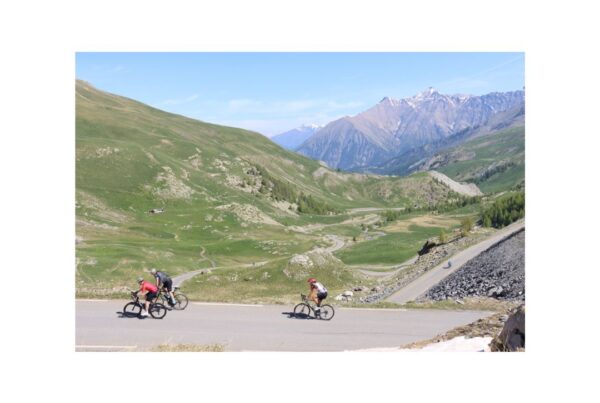Zwift’s Climb Portal answers the request that most climbers that use the platform have, which is “Can we have more climbs?” But it’s a little different than you might expect, and I will explain.
Zwift’s Climb Portal has been an absolute success since its launch on 30th June 2023 and has quickly become one of its most popular features. It provides the unique opportunity for riders to tackle some of the world’s most iconic climbs from the “comfort” of their own home. I use the word “comfort” loosely because anyone who has ridden the 17.2km Col du Tourmalet will know how uncomfortable it really is.
The Climb Portal which, according to Zwift, was developed “purely as a means to bring more climbs to the platform and give us a way to creatively refresh them on a regular basis.”
What is the Climb Portal and how do I access it?
The Climb Portal transports you to another dimension within the Zwift world where you tackle a legendary climb.
Access to the Climb portal is via the main menu or you can navigate your way there in-game. In-game when free-riding the climb portals are located close to the base of the Volcano in Watopia with one also in France.
If you access the Climb Portal from the main menu, there will be a short, flat warmup until you navigate your way to a portal that then transports you to what is effectively another dimension and the climb itself. What climbs are available will vary and their schedule can be viewed here.



The environment
This new climbing dimension is not like anything done before on Zwift. It is simply your avatar and the road, which is colour coded and broken into segments dependent on the gradient. Blue is the easiest and red being the most challenging gradient, set against a coloured backdrop, with constellations, patterns and particles to provide a sense of scale. The head-up display is packed full of useful information to assist your climb. Front and centre is the distance remaining and directly next to it is your estimated remaining time, based on your current pace. This is constantly refreshing, depending on your effort. If a constant pace is sustained, it remains steady.
Like the Alpe du Zwift when you commence the climb there are segment times that capture your power and heart rate data as you progress, with the added bonus of the percentage of the overall climb completed, being displayed
There is lots of data to help measure your ascent and this makes up for the absence of landmarks which some may use to help measure progress. I discussed this with Chris Snook, Zwift’s PR Director who informed me that “the feeling of progression is something the team was focused on which is why those floating particles exist. The team also added the ‘Allez Allez’ signs and segments to give you something to chase. The stripes on the roads were added later to try and bring more of a sense of speed.”
Zwift have done something different here and have been innovative in meeting the demands of the community to deliver more climbs. It’s not like climbing Ven-Top or Alpe du Zwift, this is different and the Climbing Portal, quite literally adds another dimension to Zwift.




The experience
The climbing experience is different to what I am accustomed to due to the lack of scenery but the volume of data allows you to control your effort and understand exactly where you are on the climb. The colour coded gradients, enable you to see the challenges ahead. However, those who do enjoy viewing the scenery and spotting the hidden treasures within the Watopia landscapes may find the limited scenery a little bit boring. In addition, the limited scenery may challenge your spatial awareness, creating the impression of little forward movement. These are all points which Zwift are aware of and are working hard to address.
Expansion
6-month since its initial release, Zwift have recently provided additional functionality allowing riders to choose from different versions of the climbs – a GPS-accurate 100% version, or easier 50% and 75% versions. Once you’ve climbed the 100% version, you’ll unlock the heroic 125% version. With this new feature, the Climb Portal will be more accessible to those who consider climbing to not be their forte, as well as providing additional gamification that will inspire those who enjoy the competitive aspect to riding. Each version of the climb will have its own leaderboard and will show Zwifters what percentile of climbers they’re in.
What climbs are available?
The following list of climbs are available at varying times:
| Climb Title | Length (km’s) | Elevation gain (meters) | Gradient (%) |
| Cote de Pike | 2.17 | 215 | 9 |
| Cote de Domancy | 2.97 | 240 | 7.90 |
| Cote de Trebiac | 4.6 | 207 | 4.20 |
| Old Willunga Hill | 4 | 252 | 6.30 |
| Col des Aravis | 5.2 | 273 | 5.10 |
| Old La Honda | 5.6 | 395 | 7.10 |
| Col du Platzerwasel | 7.82 | 592 | 7.30 |
| Crow Road | 7 | 251 | 3.58 |
| La Super Planche des Belles Filles | 8.6 | 602 | 7 |
| La Laguna Negra | 9.1 | 510 | 5.60 |
| Bealach na Bà | 9 | 632 | 7 |
| Coll d’Ordino | 10.3 | 511 | 5 |
| Rocacorba | 11.8 | 756 | 6.40 |
| Puy de Dome | 12.96 | 913 | 7 |
| Col d’Aspin | 13.54 | 807 | 5.80 |
| Col de la Madone | 16.3 | 902 | 5.50 |
| Col du Tourmalet | 17.2 | 1213 | 6.90 |

Summing up
I find the Climb Portal a very useful feature, a favourite route being the Col du Tourmalet, which is challenging but fun and I can already see that the Climb Portal keep things fresh for those who enjoy climbing with the new functionality. Ultimately, the Climb Portal provides new challenges to tackle and it enables more iconic climbs from across the world to be added to Zwift for riders to try. This should be applauded. I would hope this feature enables more climbs to make it into the maps themselves, fleshed out with scenery. Overall, I think this massively broadens the scope of training and I look forward to seeing this feature utilised for racing or group rides.



